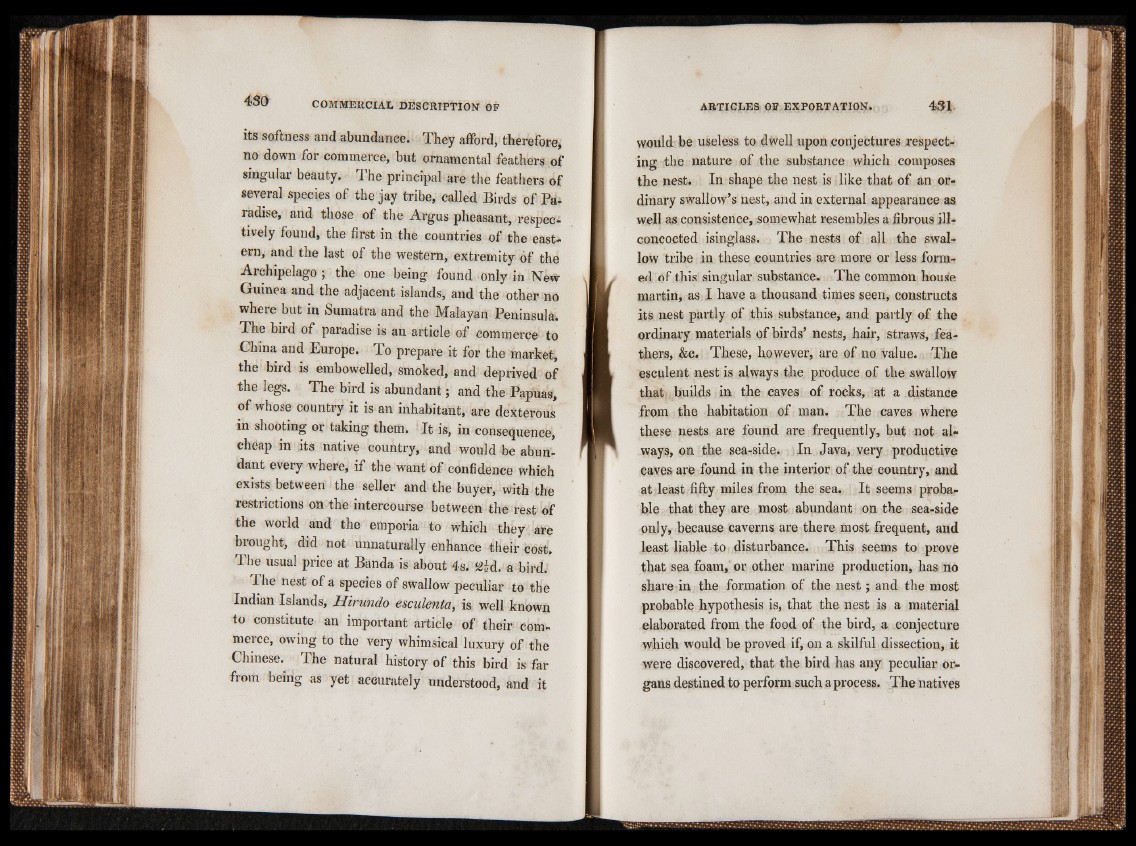
its softness and abundance. They afford, therefore,
no down for commerce, but ornamental feathers of
singular beauty. The principal are the feathers of
several species of the jay tribe, called Birds of Pa-
radise, and those of the Argus pheasant, respectively
found, the first in the countries of the eastern,
and the last of the western, extremity of the
Archipelago; the one being found only in New
Guinea and the adjacent islands, and the other no
where but in Sumatra and the Malayan Peninsula,
The bird of paradise is an article of commerce to
China and Europe. To prepare it for the market,
the bird is embowelled, smoked, and deprived of
the legs. The bird is abundant; and the Papuas,
of whose country it is an inhabitant, are dexterous
in shooting or taking them. It is, in consequence,
cheap in its native country, and would be abundant
every where, if the want of confidence which
exists between the seller and the buyer, with the
restrictions on the intercourse between the rest of
the world and the emporia to which they are
brought, did not unnaturally enhance their cost.
The usual price at Banda is about 4s. 2§d. a bird.
The nest of a species of swallow peculiar to the
Indian Islands, Hirundo esculenta, is well known
to constitute an important article of their commerce,
owing to the very whimsical luxury of the
Chinese. The natural history of this bird is far
from being as yet accurately understood, and it
would be useless to dwell upon conjectures respecting
the nature of the substance which composes
the nest. In shape the nest is like that of an ordinary
swallow’s nest, and in external appearance as
well as consistence, somewhat resembles a fibrous ill-
concocted isinglass. The nests of all the swallow
tribe in these countries are more or less formed
of this singular substance. The common house
martin, as I have a thousand times seen, constructs
its nest partly of this substance, and partly of the
ordinary materials of birds’ nests, hair, straws, feathers,
&c. These, however, are of no value. The
esculent nest is always the produce of the swallow
that builds in the caves of rocks, at a distance
from the habitation of man. The caves where
these nests are found are frequently, but not always,
on the sea-side. ; In Java, very productive
caves are found in the interior of the country, and
at least fifty miles from the sea. It seems probable
that they are most abundant on the sea-side
only, because caverns are there most frequent, and
least liable to disturbance. This seems to prove
that sea foam, or other marine production, has no
share in the formation of the nest; and the most
probable hypothesis is, that the nest is a material
elaborated from the food of the bird, a conjecture
which would be proved if, on a skilful dissection, it
were discovered, that the bird has any peculiar organs
destined to perform such a process. The natives